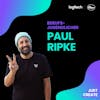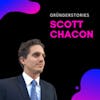Misconceptions about pitching early stage investors - with Sequoia Capital Partner George Robson
Verbessert sich das europäische Klima für Frühphasen-Startups wieder?
Nachdem das europäische Fundraising-Ökosystem ist in den Jahren nach dem Coronaboom etwas vorsichtiger war, stellt sich die Frage: wie entwickelt es sich aktuell? Fabian trifft George Robson, Partner bei Sequoia Capital, dem wohl bekanntesten Venture Capital Fonds weltweit.
Gemeinsam sprechen die beiden über die Finanzierung von Startups mit hohem Kapitalbedarf, die feine Linie zwischen optimistischer Vision und Realismus beim Pitch und die richtige Ansprache von Investoren wie Sequoia Capital.
Was du lernst:
- Welchen Investor solltest du für dein Startup suchen, wenn du eher ein cash-heavy business baust?
- Markt Einschätzung: Feiern Consumer-Produkte gerade ihr Comeback?
- Sequoia Capital: Wie investiert Sequoia und worauf legt das Unternehmen bei Gründern großen Wert?
- Wie viel Storytelling im Pitch ist gut und ab wann wird es zu viel?
- Wie wichtig ist das warme Intro wirklich und welche Chancen hast du mit Cold Outreach bei Investoren?
Here you can find tickets for MERGE: https://merge.berlin
Don’t forget to use the code UNICORN for 30% off.
ALLES ZU UNICORN BAKERY:
George Robson
LinkedIn: https://www.linkedin.com/in/georgerobson
Sequoia: https://www.sequoiacap.com/
Unicorn Bakery Whatsapp Broadcast:
Hier erfährst du alles, was du als Gründer wissen musst: https://drp.li/jrq5S
Unser WhatsApp Broadcast hält dich mit Einblicken in die Szene, News und Top-Inhalten auf dem Laufenden.
Marker:
(00:00:00) Is the European fundraising ecosystem waking up again?
(00:04:21) How do I approach investors if I'm building a startup that combines hardware and software instead of the usual b2b SaaS startup?
(00:07:12) What investor am I looking for if I'm a cash-heavy business?
(00:11:40) How does investing at Sequoia work?
(00:14:20) Are consumer products experiencing a comeback?
(00:18:15) When it comes to pitching, where is the fine line between storytelling and "being too much"?
(00:23:45) How to get in touch with Sequoia?
(00:00:00) I would include the pitch deck, but in the body of the email, tell the story. (00:00:04) And it's framing it not, you know, most of this stuff's on LinkedIn, right? (00:00:08) Where did you study? (00:00:09) What did you study? (00:00:10) Where did you work? (00:00:11) It's actually not that. (00:00:12) It's more about articulating, you know, why did you make those decisions? (00:00:15) What element, we use this phrase a lot at Sequoia, spiky, right? (00:00:19) What element of your life, the decisions you made, indicate that you are a spiky person. (00:00:22) What I mean by that is, there is some feature of your domain expertise, functional expertise, your grit and determination that you have built over the course of your life that indicates you are ready and you are the person or you are the team to be able to tackle this problem. (00:00:37) Welcome to a new episode of the Unicorn Bakery. (00:00:40) My name is Fabian Tausch, and today we will have a look at Sequoia's recipe for success. (00:00:44) We're at Start Summit, so thanks for offering us a booth to record. (00:00:49) Sequoia is probably the most renowned venture capitalist in the world, I think I could say needs no introduction. (00:00:56) I met Sequoia partner and today's guest, George Robson, joined three and a half years ago, I guess, if I researched correctly, or most of the day, after building the subscription product for Revolut. (00:01:08) And we will jump into Sequoia's style of investing, and I'll try to get a hint and look a bit behind your thoughts and mind and experience of what's happening at the moment, what you see, and how founders should approach venture capitalists like you and to help founders make better decisions. (00:01:30) So George, welcome to the Unicorn Bakery. (00:01:32) Thank you for having me on a sunny day in Switzerland. (00:01:35) Yeah, that's amazing. (00:01:37) You are traveling a lot, you're meeting a lot of founders. (00:01:41) We all heard that it was a tough time the last one or two years to raise funds. (00:01:46) What would you say is the, let's say, state of the European ecosystem? (00:01:50) Is it like waking up again? (00:01:52) Has it ever been that bad? (00:01:53) How do you think about it? (00:01:55) Yeah, I think, I mean, there's been obviously a bunch of adjustments in some of the macro around fundraising, building technology companies over the last few years. (00:02:03) I think the reality is today, it's a great time to found a great business. (00:02:06) I say that because, I mean, in terms of inputs, you know, if you have a unique idea, you have an exceptional team, you can have a concentration of not just capital and some raising money from investors, but actually of talent behind your idea. (00:02:18) It's not true today that if you're an early stage startup hiring people, you'll have hundreds of companies competing for your talent. (00:02:24) You might have relatively few. (00:02:25) I think that's one point. (00:02:27) But I think the second point that's more important is a moment in time today where you can start to use new technologies. (00:02:33) And it's not just sort of machine learning AI, but it's things like computer vision, industrial automation, robotics, things like this to attack problems that are now measured in percentage of GDP terms. (00:02:42) I think we're seeing Europe being very well positioned because we've had an incredible history going back decades in some of the largest industrial companies in the world. (00:02:49) We have a lot of manufacturing base here, where there's a lot of pressures to move manufacturing back to Europe. (00:02:54) And the only way to solve that is through technology. (00:02:56) And I think what that means is for entrepreneurs, we can actually lean into our strengths. (00:03:00) And that is domain and functional expertise that has been hard earned over time to think about building these ginormous businesses. (00:03:07) So it's a good time to build businesses, to pick huge problems. (00:03:12) And I think, do you think hardware is coming back as well? (00:03:16) I think hardware is already back. (00:03:18) And I think we see it in a whole mix of different end industries. (00:03:21) I think there's a few reasons for that. (00:03:23) I think one, as I say, we've had these sort of tectonic shifts in some of the enabling technologies, the level of precision, the level of sort of embedded intelligence in different foundational models. (00:03:33) I mean, it started, of course, in generative AI, but it's moving into physics models, use of spatial data, real world simulations, things like this. (00:03:40) And that unlocks huge opportunities in robotics when you combine it with things like computer vision, which is just so performant today. (00:03:46) I think what is really interesting is actually companies are going after relatively, what might be seen as kind of niche slices, but really they're core technologies. (00:03:54) Like we have a company in Munich called Robco that focuses on basically automating CNC machine operators, where the insight is the average age of a CNC machine operator is 58, 60 years old. (00:04:04) It takes too long to train a new one, but CNC machines are going nowhere. (00:04:07) It's a market that hides in plain sight. (00:04:09) And I think there are so many examples of things like that that exist across robotics, manufacturing, as I said, but also kind of medical devices, mobility, all these different areas and founders here are uniquely positioned to go after this problem. (00:04:22) When you look at hardware, and often they combine hardware and software nowadays. (00:04:28) So when you look at those businesses, what would you say is the crux about it? (00:04:34) Like if I'm a founder and I, because a lot of, and we don't, we're not here to bash other investors. (00:04:40) That's definitely not what we're doing. (00:04:41) But we often hear like, okay, we're only focusing on B2B SaaS. (00:04:45) So how do I go out and like convince somebody that what I'm building, like hardware and software as it makes us like what somebody else needs. (00:04:54) So how do you look at such businesses? (00:04:56) Yeah, I think, I mean, I would encourage founders who are building companies like that, whether it's in hardware specifically, or kind of broader deep tech, remembering that that probably means it's going to be a longer gestation period, a period where you're developing the technology, genuinely doing R&D in some cases to understand whether you can make delivering that service using this piece of technology, economically viable. (00:05:17) That's okay. (00:05:18) So you generally come into that, you don't just turn up and decide to found a robotics company. (00:05:22) It's probably somewhere where you built domain expertise over a few years. (00:05:25) Some of it applied, some of it in research, and don't shy away from telling those stories. (00:05:29) And I say that because many of these fantastic people that might come from academia or come from kind of industrial experience, and they're surrounded by people that they perceive as similar to themselves every day. (00:05:38) So they forget to tell those stories when they go and speak to new investors, new hires as they're building the company. (00:05:44) So tell the story properly. (00:05:45) I think too, when you think about your fundraising strategy, remembering you might have this longer period leading into kind of first revenue and first sales, you should really think about the business obviously as being milestone driven. (00:05:55) You will have these different points where you are kind of structurally de-risking the business or the technology. (00:06:00) Those will be step change moments. (00:06:02) And you're telling the story about what it takes to build this first MVP of this piece of hardware, whatever it is, articulate kind of how long will that take? (00:06:10) What are the points of validation that we will hit along that way? (00:06:13) How does that help us de-risk different components? (00:06:15) And it might be performance. (00:06:17) It might be cost. (00:06:19) It might be like the ability to manufacture the same thing, but with different supply chain components that are locally sourced. (00:06:24) So there's more redundancy built into that. (00:06:26) And what you're doing is you're building this picture, this kind of jigsaw over time of how do we go from this idea we have today to something we can sell in market that is better, cheaper, faster, more performant, whatever the dimensions are that matter for your particular technology. (00:06:39) And you're articulating it in terms of those milestones. (00:06:42) And you're kind of fundraising in many ways against those milestones. (00:06:45) And the reason that matters, just to close it out, the risk when you develop some of these companies, if you don't have that structure and that discipline, is you end up trapped between milestones in some ways, but when you next need to go out and fundraise, i.e. (00:06:56) you're saying to someone, hey, please take a leap of faith on this next big validation for what we're trying to build. (00:07:01) But it's our job as Sequoia and as your partner to really help you frame a little bit that story and the allocation of R&D and the allocation of spend to make sure it's as smooth as possible. (00:07:12) Hardware products and other companies as well have, we see it more and more, huge cash needs. (00:07:20) So they need to fundraise until they can build a product. (00:07:24) We can see this with companies like Mistral that then needed 100 million seed round, then others that like building LLMs and other companies as well that are not hardware heavy. (00:07:36) But if I'm a cash heavy business, no matter if I needed to develop my product or be scaling is, let's put scaling on the side, but like really for developing my product. (00:07:49) What does the partner look like that I'm looking for in an investor? (00:07:52) Am I going for a fund that can do my seed round and my series A? (00:07:57) Am I going for like a specific fund? (00:08:01) Because a question that I often get from founders who have a bit more cash heavy businesses, they're like, yeah, I'm thinking about talking to these multistage funds, but at the same time, I'm not sure if that makes sense to do it, because then what happens if they don't want to do my next round and I'm already pretty much dead, I think. (00:08:20) So who do I talk to? (00:08:22) So to stick with the hardware point and then to move on to the second component there. (00:08:28) So your job as a founder in terms of the fundraising process is to help you put the best team on the field, a group of people, individuals, funds, et cetera, that you believe will maximize the probability of success of your company. (00:08:41) And there are many different flavors to that to state the obvious, but I think the most important ingredient there is to think about fundraising as kind of the output. (00:08:48) The inputs are obviously the idea you have, the market you're going after, the market timing and the people you have around you in the core team, but obviously on the cap table, and that can be VCs, it can also be great angels, other partners to support you in getting there. (00:09:02) So I would really start with that filter first, thinking about people that have unique insights as partners, either to help with company building strategy, hiring for people with unique skillsets to help you increase nonlinear changes in the probability of success, distribution, which might be a combination of customer introductions, partnerships, relationships, but it might also just be strategy from having seen companies that have a similar go-to-market motion in some way to understand how to navigate that. (00:09:29) I would sort of lead on that expertise and prioritize that expertise first. (00:09:33) The output of that is some kind of shape of the company over the course of the next, say, one to two years as part of this fundraise. (00:09:39) And really when you're pitching to a VC, in some ways what you're doing is you're asking them two questions. (00:09:44) Do you like the story, the story being the shape of the company, the amount of capital it will take to get there, these different milestones and intermediate goals, and do you believe it? (00:09:52) And if you like it and you believe it, you should probably invest in that business because it implies you have kind of alignment on the size of the prize and the size of the opportunity. (00:09:59) So I would really drill into that. (00:10:00) And I would also emphasize that is as important, and in some ways, if not more important, that you have that relationship with the individual as it is you do with the fund. (00:10:08) Because obviously that person will be your primary window into Sequoia or into that particular VC, that with the person you have the most frequent touch points with, and they will be an important point of leverage for you as you think about making that trade. (00:10:21) As you described, there are different types of partners you can choose for that. (00:10:24) I mean, as we think about it as Sequoia, we have funds from a seed fund, a series A fund, a growth fund, a pre-IPO fund. (00:10:31) We are making more investments actually at seed and pre-seed than any other stage. (00:10:34) And generally the way we think about it is we want to make a small number of investments, typically kind of two to three investments per partner per year, ideally as early as possible with a view to being in business for as long as possible. (00:10:45) And we do that because we have these multistage funds, but we're also structured as Sequoia as an evergreen fund, which means that the way we think about time horizons for many of these businesses we're in partnership with is incredibly long-term because we're not restricted with these traditional fund cycles, which if you're a company that will have many phases of growth, many phases of investment and R&D, that hopefully will allow you to unlock bigger and bigger opportunities, we believe that's the right model, that's the right product, if you like, to sell to this wonderful customer, the founder, that should have product market fit. (00:11:15) The kind of companies we want to be in business with to make that fully maximized is obviously companies that will work on problems that will matter over 20, 25 years, right, if everything goes right. (00:11:25) There's a level of scale that's implied in that, a level of ambition, I think, you know, in my personal instance, the kind of people I like to work with, the level of intensity it takes for you to keep pushing over that amount of timeframe. (00:11:36) If you have that level of philosophical alignment, we think we're a good candidate. (00:11:40) Let me ask a bit more bluntly, do you think there's a signaling risk if I raise a seed from Sequoia and you're not participating or like doing the A? (00:11:49) So the evidence, the kind of data shows, no, you know, if we partner with a company at seed or pre-seed, the probability they raise a great series A is meaningfully higher than the average you see in the market. (00:12:00) On average, they raise it at a higher valuation. (00:12:02) But I think that's not the most important bit of that question. (00:12:04) I think, you know, in reality, the best way to raise a great round is to obviously be building a great business. (00:12:10) And again, if you think your primary input into that around a fundraise is making sure you put the best team on the field, and you think that, you know, we are working hard to hopefully provide insight, understanding, structure, and experience around building that particular type of business, that will will do everything in our power, obviously, to de-risk that, to make sure it goes right. (00:12:29) It's obviously not true for every investment we make at seed, we follow on in the series A. Our responsibility is to be a good steward, you know, to you and the company and recognize as well that Sequoia is a multistage fund. (00:12:38) We don't always get that decision right. (00:12:39) You know, there are instances where we've been smart enough to lead a seed round, not smart enough to lead the series A, and worked hard enough to still be obviously supporting the company, having a relationship with the company, and come back and lead the series B or the series C. (00:12:51) And I would also emphasize, you know, sometimes you can think about it as, you know, is this a chance to pitch Sequoia? (00:12:56) Is there any one opportunity to speak to us? (00:12:58) Absolutely not. (00:12:59) You know, you've never the last time to pitch us by having these different funds, we catch companies at different points in their arc. (00:13:04) We would much rather build that relationship and start to get to know you in advance of making an investment, even if it's one to two years prior to making it. (00:13:12) I think for somebody who's not like too familiar with the structure, so let's say I talk to you in very early pre-seed phase, you say we're not doing the investment. (00:13:25) Do I talk to you again when I'm like at A or B, or do I talk to other people just to make it more specific for founders? (00:13:31) Yeah, so we have a relatively small team at Sequoia, so there's a lot of shared context in the partnership of what's happening with companies. (00:13:39) Broadly, what happens is, you know, I will work with businesses most typically at seed and pre-seed through the series A, a little bit of growth stage if it's around FinTech, if I was at Revolut prior to joining Sequoia. (00:13:50) But broadly, we have growth colleagues who focus on that next stage of growth, helping companies go from obviously post-product market fit to aggressively scaling into capturing that market opportunity. (00:13:59) But what I'd emphasize, you know, that's an us problem, not a you problem as a founder, right? (00:14:03) I will absolutely, and I do frequently, you know, re-engage with founders that I've got to know over the last three and a half years. (00:14:09) It's our responsibility or my responsibility to sort of provide that right window into Sequoia to find you the right partner to help you with that next stage of growth. (00:14:17) So absolutely, you should reach back out to the person you've been in contact with. (00:14:20) Yeah, just sometimes we need to be specific. (00:14:23) How do you think about consumer, like the consumer market? (00:14:28) Because we haven't seen too many consumer deals in the last years, like at least younger companies emerging. (00:14:35) So everybody said, yeah, we're focusing on B2B SaaS now. (00:14:38) My thesis is that the consumer part is coming back more and more. (00:14:42) We see here and there, we see like larger A's, A extensions in the German market. (00:14:47) We see it also in other markets. (00:14:49) And I think there, because so many people think we should do software, like B2B software, there is an edge to build consumer products at the moment. (00:15:00) Yeah, I think if you look at technology over the last 20, 25 years, there were two big trends that have enabled a lot of the market cap and a lot of the great companies to be built. (00:15:10) One, of course, is the emergence of mobile, right? (00:15:11) And the app stores and the iPhone and things like that. (00:15:14) And two is the emergence of cloud, right? (00:15:16) And migration from on-premise to cloud. (00:15:18) What that means is that for the early innings on the first point, a lot of it was taking models that worked in other mediums, right? (00:15:25) It could be branch-based businesses, web-based businesses, and taking it to mobile. (00:15:29) And you could argue Europe in particular has been an incredible beneficiary of that because of the rise of fintech. (00:15:34) A lot of fintech was doing exactly that, taking web banking, making it mobile banking. (00:15:38) And Revolut, of course, and companies like that and Klarna have been successful use cases. (00:15:43) I think what is interesting is some of those markets have become more saturated. (00:15:46) It doesn't mean consumer is over. (00:15:47) There are actually two big drivers at the moment we see that are enabling change. (00:15:51) One is that cohorts of those customers that signed up to some of those early products are just older and more mature. (00:15:58) Their needs have changed, right? (00:15:59) Their lifestyles have changed. (00:16:00) They have more money. (00:16:02) They want to shop in different ways. (00:16:03) The culture built around transacting online, building friends online, building communities have shifted. (00:16:08) And in some ways, that's a reaction against those properties. (00:16:11) In some instances, it can be a reaction. (00:16:13) It's been fascinating to see consumer social really coming back and actually Europe playing an outsized role in some of those early stage companies. (00:16:20) A lot of those businesses focused on authenticity, real friends, connections, in some ways seen as a response to some of the different platforms that have established over the last 10 years. (00:16:28) So I think that's point one. (00:16:30) I think point two is, and not to understate this because it's still so early, I think this ability to have a much more personalized experience online across so many more dimensions than just what adverts you see is something that is still taking shape. (00:16:43) And AI is at the very core of that. (00:16:45) And you've seen successful businesses in the States like Character.ai and businesses like that that have provided a much more human interface for you to interact with very sophisticated technology that knows you, increasingly seems to care about you and allows you to build these different levels of connections and insight. (00:16:59) So I think we should be excited about both of those trends and they create large opportunities for founders. (00:17:04) Yeah, I'm interested in seeing a bit more diverse pitches again and not like all pretty much looking the same. (00:17:10) Yes, please. (00:17:10) Yeah. (00:17:11) So let's talk about pitching and then talk about pitching Sequoia because we have, like as founders, you often have the issue of like, okay, I know all the stuff that's not working. (00:17:24) I know where I want to go. (00:17:25) I have to bridge a lot of time in my pitch, like from I'm at A, this point where pretty much nothing happens at pre-seed to I want to be a billion dollar company or maybe 10 billion or a hundred billion company, like depending on what market I pick, what problem I want to solve. (00:17:48) Where is the fine line between being a storyteller and like engaging you for the vision and overselling and being like too much and being the person where you're like, yeah, cool. (00:18:02) But I don't think that's what's going to happen. (00:18:05) Yeah, I think that's a really important question. (00:18:06) I think two pieces on style as well, just before that, I think one, you know, I would really emphasize particularly at pre-seed, you know, it's you and your small founding team with limited resources, no product, no team against the world. (00:18:20) And at that stage, what we're doing is we're trying to build faith in you really as individuals, right? (00:18:25) You as a small team of exceptional people to go out and change that. (00:18:28) So tell your founding story and not just the founding story of the business, but the founding story really of you as a person, right? (00:18:34) Actually, we spend a lot of time going back before, where does that initial crux of motivation come from? (00:18:39) And the answer is often not when I worked at this company and learned about this thing, it might not even be a university. (00:18:43) It might be something that when you were a child, you know, your mom always encouraged you to explore music or do X, Y, Z, or try these things. (00:18:50) And it was sort of the kernel of some interest that grew over time over the next 10 or 15 years, even into something that's leading you to this point. (00:18:58) So always provide your personal founding story as much as the company is point one. (00:19:01) I think point two is, you know, when you come to these pitches, I think there are lots of like wonderful blogs, all these things about these fantastic founders and their arcs, but you should kind of come authentically as you are. (00:19:11) I say that because you will be building a business, hopefully in partnership with us over the next 10, 15, 20 years. (00:19:17) You can't pretend to be something you're not, and you can't build a culture in any way that isn't authentic to yourself. (00:19:22) So I'd really encourage you to feel relaxed in that way, you know, and try and find that human fit with people. (00:19:27) So just on the input side, your question around kind of how do you frame the story to both, you know, articulate someday you want to take the business to Mars, but today you're building HR tech. (00:19:36) How do you bridge those two crazy worlds? (00:19:38) Something like that. (00:19:40) Um, we always recommend is use this phrasing of acts, right? (00:19:43) Your act one is this wedge product. (00:19:45) That wedge product helps you own an initial relationship with a customer. (00:19:49) If you think about a business like Revolut, that was free FX, right? (00:19:51) Multi-currency accounts. (00:19:53) It's not easy to build a generational company around FX, but that is a fantastic wedge in Europe given the high density of currencies. (00:19:59) But the act two is your expansion on that. (00:20:01) How do you double down? (00:20:01) So for Revolut, it was everyday banking from that into investing. (00:20:04) And that's how you start to ladder your way from something like free FX, which is relatively niche to this headline grand vision of financial super app. (00:20:12) Each of those incremental steps is believable. (00:20:14) Even if going from A to Z is always going to be complex. (00:20:18) So I think, um, to, to go a bit in the weeds on the first part, that definitely means I don't send you my pitch deck first. (00:20:25) I, I have to get to know you because otherwise I can't tell you my story in that way. (00:20:29) Well, I think so. (00:20:31) I would include the pitch deck, but in the body of the email, tell the story. (00:20:35) And it's framing it, not, you know, most of this stuff's on LinkedIn, right? (00:20:39) Where did you study? (00:20:40) What did you study? (00:20:41) Where did you work? (00:20:41) It's actually not that. (00:20:43) It's more about articulating, you know, why did you make those decisions? (00:20:46) What element, we use this phrase a lot at Sequoia, spiky, right? (00:20:50) What element of your life, the decisions you made indicate that you are a spiky person. (00:20:53) What I mean by that is there is some feature of your domain expertise, functional expertise, your grit and determination that you have built over the course of your life that indicates you are ready and you are the person or you are the team to be able to tackle this problem. (00:21:08) And telling that story, I think in terms of, you know, small examples, I think pointing to these indications where you had real agency, right? (00:21:16) I think, you know, an interesting interviewing question when you interview people is to say, if you weren't there, what wouldn't have happened, right? (00:21:21) It's in some way trying to articulate that, yes, you know, you did all of these things, but you had agency in deciding to do them. (00:21:27) And when you were there, you'd make these, you know, seminal or important contributions. (00:21:31) So, like, put it a bit more into perspective. (00:21:35) I could say, OK, I started a podcast seven and a half years ago because I think it needed more entrepreneurial content. (00:21:40) Or I say, hey, honestly, I was unhappy with the university and I wanted to learn from people about entrepreneurship, but I didn't know where, especially in the German market. (00:21:49) So I needed a way to get in touch with founders. (00:21:51) And I knew that I can't meet them for lunch because I'm a 19-year-old kid. (00:21:56) So how do I get that? (00:21:58) The vehicle for that was the podcast. (00:21:59) So, like, a bit more like that. (00:22:01) That is exactly it. (00:22:02) And the interesting takeaway from that is, you know, having that insight of I want to learn about startups and I want to meet people is interesting enough. (00:22:09) It's a great start. (00:22:10) But most people do nothing about it, right? (00:22:12) But then having the agency, again, if you weren't there, what wouldn't have happened? (00:22:15) The answer to that question is all of this, this podcast, everything we're doing right now. (00:22:19) That's the interesting bit, because that's the bit that makes you you and indicates why you turn left and everyone else turn right. (00:22:25) Yeah. (00:22:25) Yeah. (00:22:25) Just to give an example of how people can think about, OK, I could tell, I thought we needed this and that's why I did it. (00:22:31) Or, OK, what was the actual decision process in my head? (00:22:36) And I would include that in the body of the email. (00:22:37) The deck, sure. (00:22:38) But that tells us who you are and why you are that way. (00:22:41) Do you actually read cold outreach via email or do you? (00:22:45) I think even more than that, I try and I think I do respond to basically every single one. (00:22:51) Yeah. (00:22:51) That's probably something that's not true for every VC out there. (00:22:56) But still, it's good to hear that for founders, I think, encouraging to still try, because everybody's like, you always need an introduction. (00:23:05) You always need an introduction. (00:23:06) I mean, even more than that, all our emails are on our website. (00:23:09) So if you look at Georgia Sequoia Cap, that's my email. (00:23:12) Yeah. (00:23:13) I think, how would you value the introduction versus getting it cold? (00:23:22) I think introductions help insofar as they provide that additional context. (00:23:28) Again, it's easier for us to understand more about you when we have some understanding of where you come from and what you have worked on. (00:23:35) I want to emphasize is it's not critical in today's world. (00:23:39) Again, that's why we have this, our emails are on the website, as I said. (00:23:42) I think the most important piece to emphasize there, though, is telling that story quickly and succinctly about yourself and your personal founding story is not something we do very often. (00:23:51) And I think as Europeans, it's not something that necessarily feels natural, but develop that muscle because what you will discover is actually, if you're building the company, you will be telling a version of that same story to the first investors, your first employees, and your first customers. (00:24:04) So get really good at it. (00:24:06) It's what I would emphasize. (00:24:07) Yeah, it's interesting. (00:24:08) I hope this gives a lot of hope or a grit to founders to also do cold outreach. (00:24:15) At the same time for you specifically, if we're listening, okay, at Sequoia, we do per part in two to three deals a year. (00:24:20) That still means that thousands of pitches are not the right to be invested in. (00:24:29) But we would emphasize not now because we can always come back. (00:24:34) Fair enough. (00:24:35) But that's also a typical VC answer, right? (00:24:40) With every fund that I'm talking to or with every founder, they're like, most of the funds that are like, let's say I'm at pre-seed and they can also do seed, they're like, yeah, this and they often, and I'm not saying that you're doing it the same way, but often are putting up, it's not yet there where we want it to be, but not being precise about what they don't like or why it might not work. (00:25:03) Or even if they would say, hey, we will never invest in this business, they will let a foot in the door. (00:25:08) And instead of saying, hey, because of course it can pivot, it can change. (00:25:12) And then maybe it might be the right thing at the next stage. (00:25:15) But it's very unsatisfying for a lot of founders. (00:25:19) I would say on that, firstly, I think it's something that I personally try and spend a lot of time on specifically around passing. (00:25:27) Reason being that, again, it is a not now for us because we have these multi-stage funds literally. (00:25:32) But in practice, we would always love to invest in every business if it's doing well. (00:25:37) We don't always know the answer. (00:25:39) Founders come from these areas of deep domain expertise. (00:25:41) I found that by sharing some of those perspectives, obviously, it gives a platform for people to challenge you, which is great because we're here as much to learn about from yourselves as founders of companies as vice versa. (00:25:52) I think the other piece I would emphasize is it's on founders as well. (00:25:54) If you feel you're not getting clarity there, just to ask and try and create the space where a VC might not feel comfortable always giving that direct feedback. (00:26:02) If you say, hey, what is the one, two or three things that you would need to see to change your mind? (00:26:07) Maybe that's the easier way to trying to get to the same level of clarity of what is the metric that didn't meet the bar? (00:26:12) What is the attribute of the market? (00:26:14) What is the validation around a particular distribution strategy? (00:26:17) Whatever it is, you just try and get some indication by asking that question in that way. (00:26:21) I can not go into too much detail because otherwise I get my hands cut off. (00:26:26) But there are VCs that I know where the interns, for example, then write just the passing letter because the partners or principals or whoever don't want to take their time. (00:26:38) And then it becomes a bit more vague, even when they try to put in the right things. (00:26:42) If you didn't follow up with it, then often you're already out of the email flow. (00:26:47) Let's put it that way. (00:26:51) I haven't tried it, but I'll trust you there. (00:26:54) So when we talk about the different, I think the earliest part to get in touch with Sequoia is ARK. (00:27:04) I think it's basically a seven-week program that you're doing once a year in Europe and twice a year in the US. (00:27:09) Yeah, so it started back in 2018, 2019. (00:27:14) We used to run a program that was called Preamp at the time that was effectively post-investment, a way to onboard founders into the Sequoia community. (00:27:22) So it was meeting other founders at a similar stage, talking about some of the early company building ideas that we felt would matter over the first 18 months of building the business. (00:27:31) ARK is really the evolution of that, and in some ways, giving it a name and giving it a website. (00:27:36) And I think that really the way it sits today, so we do two cohorts a year. (00:27:39) They are a joint cohort across US and Europe. (00:27:41) We like that because it's obviously a great way to meet founders across a wider pool of experiences, backgrounds, perspectives, and industries. (00:27:49) We're running it as a relatively small cohort, typically 10 to 15 companies, many of those businesses just starting out at pre-seed, as you say. (00:27:56) And really the goal of the program, introduce you to similar founders at a similar stage, recognizing the early stage company building can be a lonely experience if you don't have that village of people around you to support you. (00:28:07) Really targeting the set of company building ideas, and I use that word, it was more than just thinking about finding product market fit, doing customer research, validation of your idea. (00:28:17) It's also thinking about how do you set up your culture? (00:28:20) And is that culture going to be high performing? (00:28:22) And how does that get replicated into how you think about your hiring strategy? (00:28:25) And some of the mechanics of how to actually go out and build a scalable hiring process, recognizing that we have many great smart founders who have not necessarily done that previously. (00:28:34) How to think about fundraising strategy within that. (00:28:37) So it's a little bit broader than just early product market fit work, because the goal is to really target many of the different ideas and concepts that will matter over the first 18 to 24 months of the business. (00:28:46) And the goal of the program, if we do something right, is to hopefully help you get to a level of clarity on some of those most important questions as early as possible. (00:28:55) So for everybody listening, I can just go on the website, apply, and then hopefully I'm one of the 10 to 15 companies. (00:29:03) Exactly. (00:29:03) Yeah, yeah. (00:29:04) There are open applications for it. (00:29:05) Absolutely. (00:29:06) Again, as a way of trying to open up people who feel comfortable approaching Sequoia. (00:29:10) But it's also something that you can apply for anytime. (00:29:12) Effectively, companies that we invest in at Seed and Pre-Seed are all eligible to join the program. (00:29:18) So yeah, reach out whenever, irrespective of whether there's a cohort or a current application period that's open. (00:29:23) Okay, amazing. (00:29:25) I think we've got to look into the Sequoia ecosystem, a bit of a state of European tech in a few different markets, and a bit more into the weeds of like, how do I approach investors to actually hook them on my story as well, and what I do, what I don't do. (00:29:43) So George, it's been an absolute pleasure. (00:29:45) I'll link to your LinkedIn profile, but also ARC in the show notes. (00:29:51) I'd say we will find another time, another event where we will do a catch up. (00:29:55) Thank you, sir. (00:29:56) Thank you for having me. (00:29:56) Thank you.
Neu hier?
Dann versuch es doch mal mit den beliebtesten Episoden des Podcasts.

























